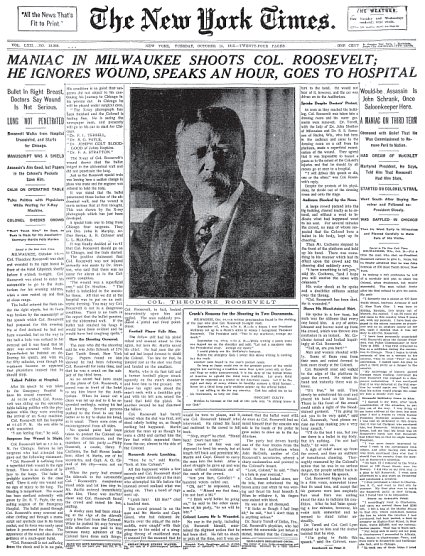Good morning.
A windy day with a high temperature of sixty-one awaits Whitewater.

Ninety-nine years ago,
On the night of October 14, 1912, Theodore Roosevelt was shot in Milwaukee. Roosevelt was in Wisconsin stumping as the presidential candidate of the new, independent Progressive Party, which had split from the Republican Party earlier that year. Roosevelt already had served two terms as chief executive (1901-1909), but was seeking the office again as the champion of progressive reform. Unbeknownst to Roosevelt, a New York bartender named John Schrank had been stalking him for three weeks through eight states. As Roosevelt left Milwaukee’s Hotel Gilpatrick for a speaking engagement at the Milwaukee Auditorium and stood waving to the gathered crowd, Schrank fired a .38-caliber revolver that he had hidden in his coat.
Roosevelt was hit in the right side of the chest and the bullet lodged in his chest wall. Seeing the blood on his shirt, vest, and coat, his aides pleaded with him to seek medical help, but Roosevelt trivialized the wound and insisted on keeping his commitment. His life was probably saved by the speech, since the contents of his coat pocket — his metal spectacle case and the thick, folded manuscript of his talk — had absorbed much of the force of the bullet. Throughout the evening he made light of the wound, declaring at one point, “It takes more than one bullet to kill a Bull Moose,” but the candidate spend the next week in the hospital and carried the bullet inside him the rest of his life.
Schrank, the would-be assassin, was examined by psychiatrists, who recommended that he be committed to an asylum. A judge concurred and Schrank spent the remainder of his life incarcerated, first at the Northern Hospital for the Insane in Oshkosh, then at Central State Hospital for the criminally insane at the state prison at Waupun. The glass Roosevelt drank from on stage that night was acquired by the Wisconsin Historical Museum. You can read more about the assassination attempt on their Museum Object of Week pages.
Source: Wisconsin Historical Society.
